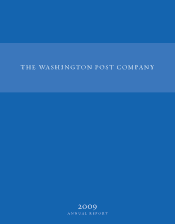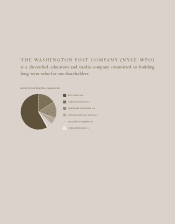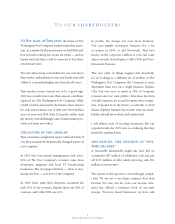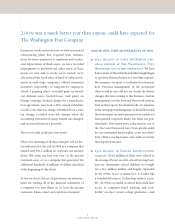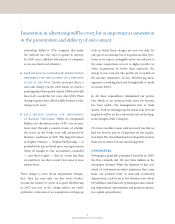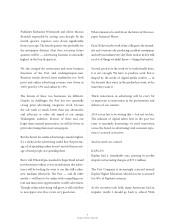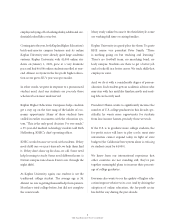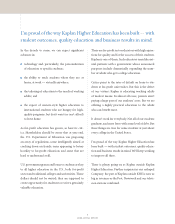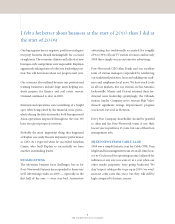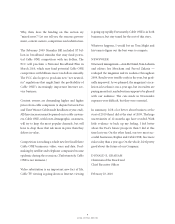Washington Post 2009 Annual Report Download - page 7
Download and view the complete annual report
Please find page 7 of the 2009 Washington Post annual report below. You can navigate through the pages in the report by either clicking on the pages listed below, or by using the keyword search tool below to find specific information within the annual report.
5
2009 ANNUAL REPORT
Publisher Katharine Weymouth and editor Marcus
Brauchli responded by cutting costs sharply. By the
fourth quarter, expenses were down significantly
from a year ago. The fourth quarter was profitable for
the newspaper division (that does not mean future
quarters will be — advertising business is seasonally
highest in the fourth quarter).
We also merged the newsrooms and most business
functions of the Post and washingtonpost.com.
Business results showed some similarities too: both
print and online advertising revenue were down in
2009, print by 23% and online by 13%.
The futures of these two businesses are different.
Despite its challenges, the Post has two unusually
strong print advertising categories: retail, because
the ads work so much better than any alternative,
and advocacy or other ads aimed at our unique
Washington audience. Because of these and our
larger-than-normal penetration, we will do better in
print advertising than most newspapers.
But the future for online advertising is much brighter.
It’s a cliché in the advertising world that the percent-
age of ad spending online doesn’t match the percent-
age of time people are spending there.
But it will. When Pepsi canceled its Super Bowl ad and
put the money online, it was an indication that adver-
tisers will be looking for ways to use this still-rather-
new medium effectively. The Post — and all other
media — will have to be online with compelling con-
tent and innovative opportunities to offer advertisers.
Though online advertising will grow, it will only flow
to newspaper sites if we create very good ones.
What remains to be said about the future of the news-
paper business? Plenty.
First, I believe in the work of my colleagues, the journal-
ists and everyone else producing excellent newspapers
and web journalism every day. Their work at its best tells
us a lot of things we didn’t know — things that matter.
Second, good as is the work we’ve traditionally done,
it is not enough. We have to produce work that is
shaped by the needs of digital-media readers — in
the formats they want, in the media they want, at the
times they want it.
Third, innovation in advertising will be every bit
as important as innovation in the presentation and
delivery of our content.
2010 is very late to be writing this — but not too late.
The infusion of digital talent here in the past two
years is extremely heartening; we need innovation
across the board, in advertising (and customer expe-
rience) as much as in news.
And we need cost control.
KAPLAN
Kaplan had a remarkable year, growing its profits
despite restructuring charges of $33.2 million.
The Post Company is increasingly centered around
Kaplan Higher Education, which last year accounted
for 58% of Kaplan’s revenues.
As the recession took hold, many Americans had an
impulse: maybe I should go back to school. With

